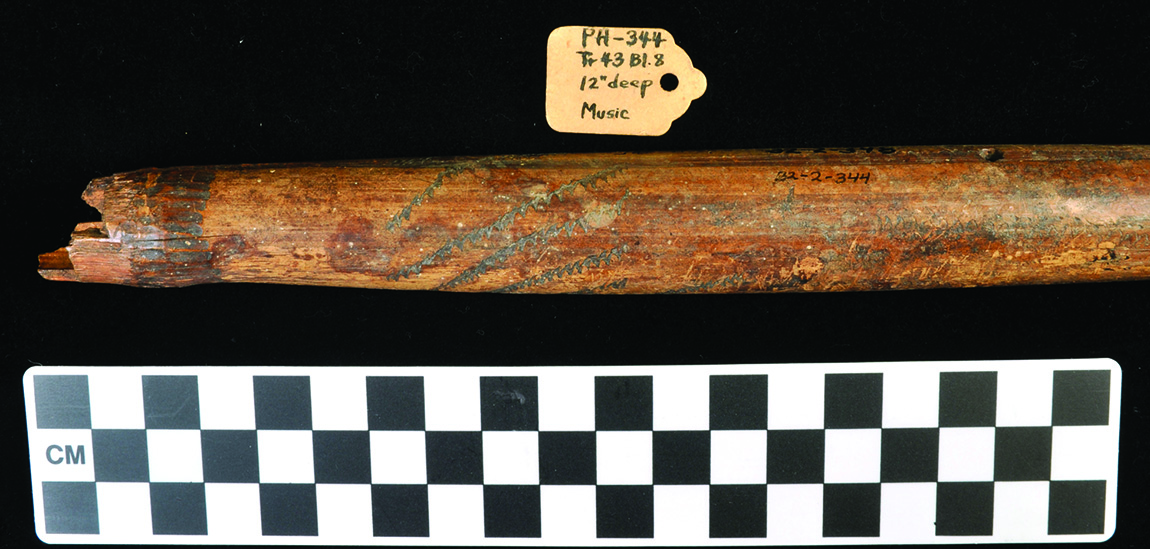
Jim Rees, Arkansas Archeological Society president
Artifact of the Month - July 2020
The Breckenridge flute (32-2-348, U of A Museum Collections), found in the Breckenridge bluff shelter in 1932, is a two-chambered block and fipple external duct flute made of river cane. It is a prototype of the modern Native American Flute (NAF) and is the oldest known example of this type of flute. At 31.5 cm in length and 1.8 cm in diameter, it is almost intact missing only a portion of the slow-air-chamber (SAC) at its proximal end. Like all NAFs the Breckenridge flute has two chambers, the shorter blow-chamber (SAC) at the proximal end and the longer sound chamber at the distal end. The two chambers were separated by an internal barrier. In order for air to travel from the blow chamber to the sound chamber a channel was carved over the barrier on the outside of the flute. This channel connects to openings on either side of the barrier so that an air duct was created when the channel was covered with some sort of blocking mechanism. When the flute was played a stream of air formed inside the air duct and was directed at the edge of the opening on the sound chamber side of the barrier (fipple). As in all flutes it was the splitting of the air stream against that edge that caused the instrument to sound. The sound chamber has four stops or finger holes which could be opened or closed allowing the musician to change pitches and play melodies (Rees 2011:6–8; 2020:181–182). At the very end of the flute outside of the sound chamber proper is a smaller fifth hole which had nothing to do with its sound. Holes like this are sometimes found on modern NAFs and today are called wind holes or direction holes. These holes are said to represent the four winds or sacred cardinal directions (Spotted Eagle 1997:29; Conlon 2017:108). The surface of the sound chamber is decorated with engraved designs consisting of zigzag lines and ticked arches which have had dark pigment rubbed into them.
The flute was found in the Breckenridge bluff shelter (3CR2) by a crew of excavators under the direction of Professor Samuel Dellinger, who was director of the University of Arkansas Museum at the time. The site is located in the Ozark highlands of northwest Arkansas and has received considerable attention from professional archeologists over the years starting with Mark R. Harrington (1960) in the 1920s. More recently in 2013 excavations by the Arkansas Archeological Survey led to the discovery of a cultural deposit at the lowest levels of the site that yielded the oldest date so far recorded in the state at some 9,765 years before present (Hilliard et al. 2015:12; Hilliard 2016:12). However, it was Dellinger’s crew working in 1932 who found the flute at the one-foot level according to their field notes. In the in situ photograph the excavators made of the flute, it is possible to see the remarkable preservation of organic materials found in the dry zone of the shelter. Pictured along with the flute there is a decorated arrow shaft made of river cane, a maize cob, a cane basket splint, and several pieces of gourd and squash.

Thanks to the cooperation of the Osage Nation, a generous grant from the Archeological Research Fund of the Arkansas Archeological Society, and permission from the University of Arkansas Museum Collections, an AMS date was obtained on the flute in 2013 from Beta Analytic. The date range of the flute indicates that it was made sometime between AD 1020 and 1160. This places the flute in a transition period for this region between the late Woodland and early Mississippi periods (Rees 2013:11–12).
So far, the Breckenridge flute is a one-of-a-kind artifact. No other flute like it has been found, and its rarity raises many questions about the distribution of flutes of this type through time and space. Perhaps its greatest significance lies in the fact that it shows the sophisticated nature of modern Native American Flutes to be part of an ancient tradition stretching back at least a thousand years.
If you would like to know more about the Breckenridge flute, go to this website designed by Clint Goss (2011). You will find there a short piece played on a working model of the flute that will give you some idea of what the original flute probably sounded like.
References
Conlon, Paula J.
2017 The Native American Flute Tradition in the Southern Plains, Focusing on the Kiowa and Comanche Tribes. In Flower World: Music Archaeology of the Americas – Mundo Florido: Arqueomusicologia de las Americas 5, edited by Matthias Stockli and Mark Howell, pp. 103–121. Ekho Verlag, Berlin.
Goss, Clint
2011 A Brief History of the Native American Flute. http://flutopedia.com/naf_history.htm, accessed April 5, 2020.
Harrington, Mark R.
1960 The Ozark Bluff-Dwellers. Indian Notes and Monographs, vol. XII. Museum of the American Indian, Heye Foundation, New York.
Hilliard, Jerry D.
2016 Breckenridge Shelter (3CR2) Radiocarbon Dates from an Early Hearth. Field Notes, Newsletter of the Arkansas Archeological Society 388:12.
Hilliard, Jerry D., Jared Pebworth, Mike Evans, and Aden Jenkins
2015 Radiocarbon Results from Breckenridge Shelter(3CR2): Hearth with Dalton Breckenridge Dates to ca. 9765–9555 B.P. Field Notes, Newsletter of the Arkansas Archeological Society 385:12.
Rees, James A., Jr.
2011 Musical Instruments of the Prehistoric Ozarks. Field Notes, Newsletter of the Arkansas Archeological Society 361:3–9.
2013 The Breckenridge Flute Dated with ARF Grant. Field Notes, Newsletter of the Arkansas Archeological Society 385:11–12.
2020 A Survey and Analysis of Sound-Making Artifacts from Bluff Shelter Sites in the Ozark Plateau Region of the Central United States. In Flower World: Music Archaeology of the Americas – Mundo Florido: Arqueomusicologia de las Americas 6, edited by Matthias Stockli and Mark Howell, pp. 175–185. Ekho Verlag, Berlin.
Spotted Eagle, Douglas
1997 Voices of Native America: Native American Instruments and Music. Eagles View Publishing, Liberty, UT.
 Collections and items in our institution have incomplete, inaccurate, and/or missing attribution. We are using this notice to clearly identify this material so that it can be updated, or corrected by communities of origin. Our institution is committed to collaboration and partnerships to address this problem of incorrect or missing attribution. For more information, visit localcontexts.org.
Collections and items in our institution have incomplete, inaccurate, and/or missing attribution. We are using this notice to clearly identify this material so that it can be updated, or corrected by communities of origin. Our institution is committed to collaboration and partnerships to address this problem of incorrect or missing attribution. For more information, visit localcontexts.org.
 The Arkansas Archeological Survey is committed to the development of new modes of collaboration, engagement, and partnership with Indigenous peoples for the care and stewardship of past and future heritage collections.
The Arkansas Archeological Survey is committed to the development of new modes of collaboration, engagement, and partnership with Indigenous peoples for the care and stewardship of past and future heritage collections.
 The TK Notice is a visible notification that there are accompanying cultural rights and responsibilities that need further attention for any future sharing and use of this material. The TK Notice may indicate that TK Labels are in development and their implementation is being negotiated. For more information about the TK Notice, visit localcontexts.org.
The TK Notice is a visible notification that there are accompanying cultural rights and responsibilities that need further attention for any future sharing and use of this material. The TK Notice may indicate that TK Labels are in development and their implementation is being negotiated. For more information about the TK Notice, visit localcontexts.org.
